This thread is a recreation of a compilation thread I originally posted on the 31st of October 2014. I consider this a historical reference and visual inspiration thread for writing about the era of the First World War, specifically the eastern front between Austria-Hungary and the Russian Empire, particularly in the years of 1914 and 1915 during military operations in the East Carpathians of what is nowadays easternmost Slovakia, westernmost Ukraine and southeastern Poland.
This thread also includes the contents of another older thread, originally posted on the 8th of May 2013, which was a brief report on my stay at one of the WWI battlefield reenactment events I am sharing in this new and definitive version of the compilation thread.
The only contents of the former two threads I am preserving in this new thread are longer posts by me. I am not copying and will not copy any feedback posts of other board members made in the two original versions of these older threads.
----
Here are my own photos from all the WWI commemoration events that I have attended thus far during this decade, particularly during the last three years. Here's the overview, starting with the oldest event and ending with the latest... Click the spoilers to see photos.
----
The Carpathian Front 1914-1915: Uncovering the Past (11th November - 31st December 2010)
Poster of the 2010 exhibition
News release on the 2010 exhibition
A fairly small (single-room), pre-centennary temporary exhibition in the Vihorlat Museum in Humenné. Organised in late autumn and winter of 2010, in close cooperation with the historical research and heritage association Klub vojenskej histórie Beskydy (Club of Military History Beskydy) from the same town. (You can find their older website archived here, the new website is currently being worked on.)
----
Karpaty 1914/1915 Výrava (20th April 2013)
Poster of the 2013 Výrava event (1)
Poster of the 2013 Výrava event (2)
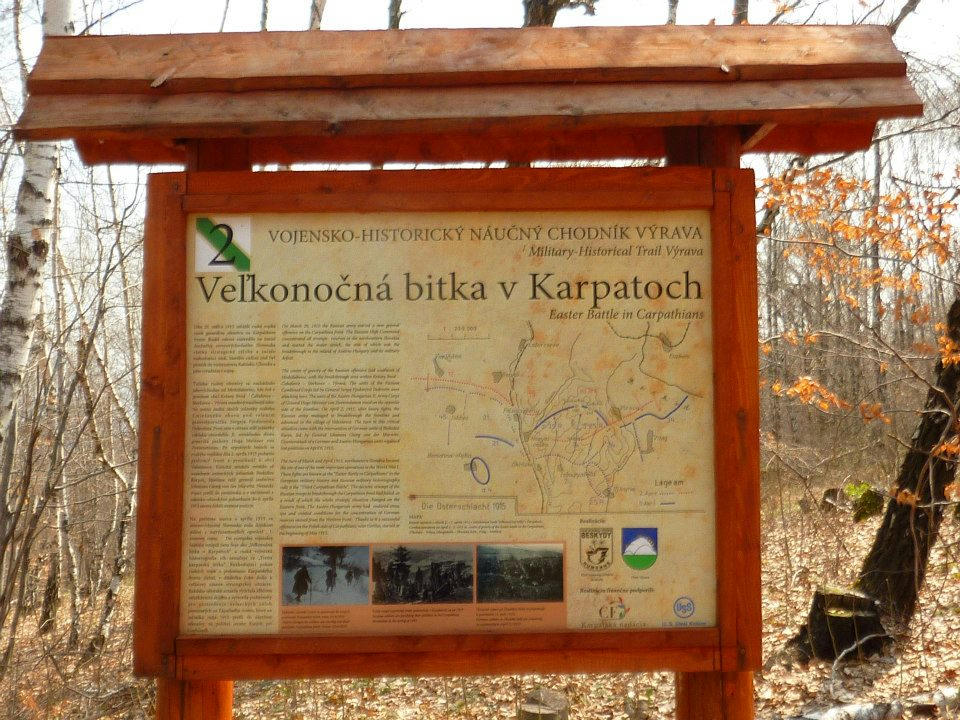
Educational trail above Výrava, to the local WWI cemetery. This sign is about the Easter Battle of 1915, close-up on map here.
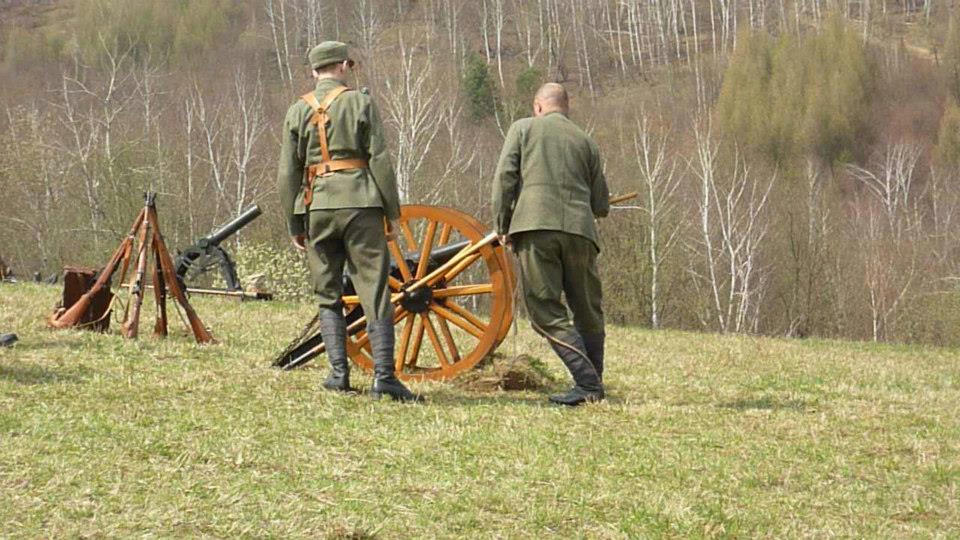
Austro-Hungarian artillery (the artillery piece seems similar to a 7 cm Gebirgskanone M.99)
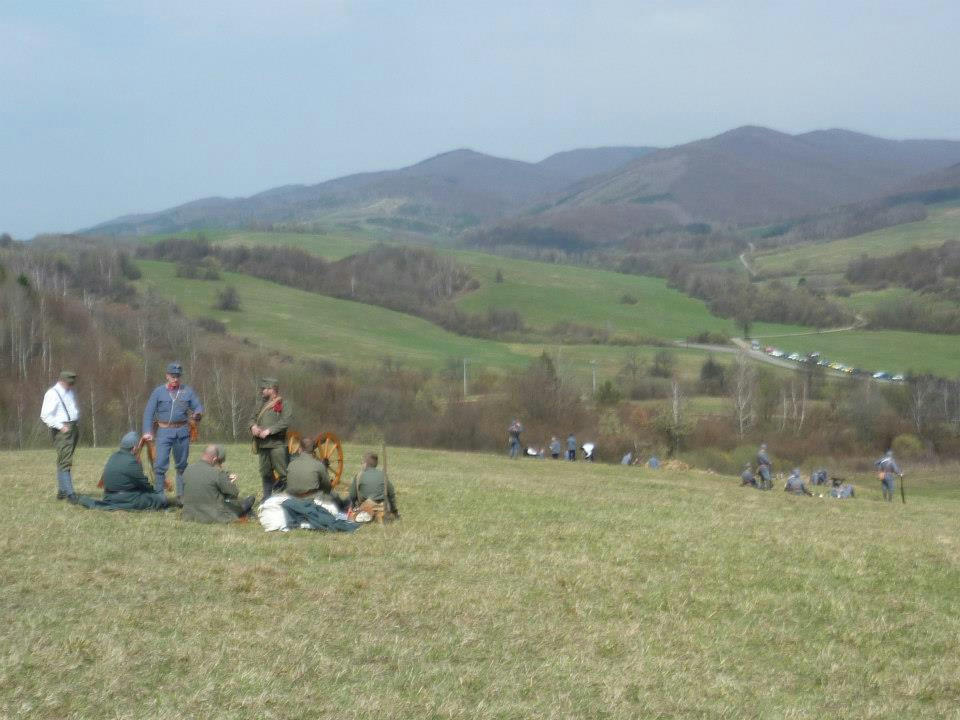
Reenactors resting, quiet before the storm
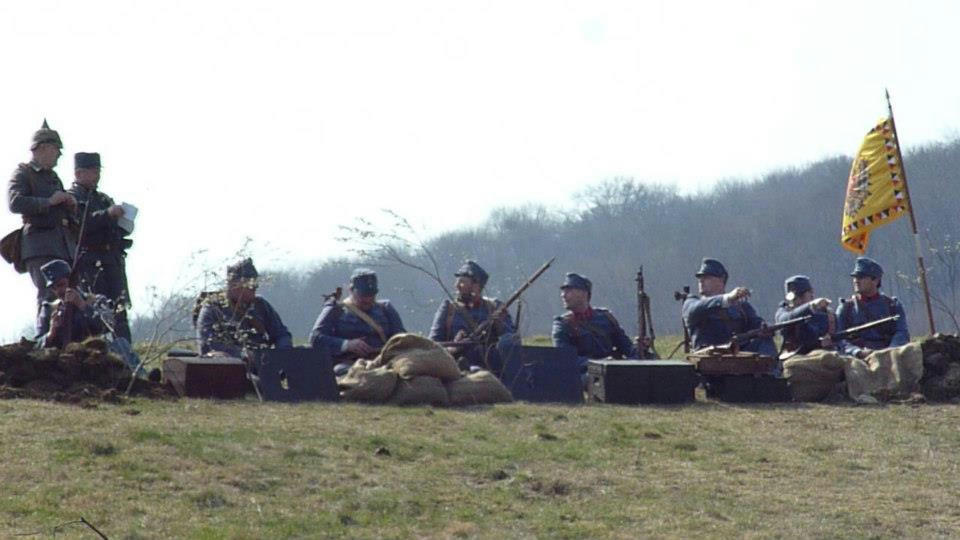
Austro-Hungarian soldiers and some allied German expeditionary soldiers in their uphill trenches, with regimental flag
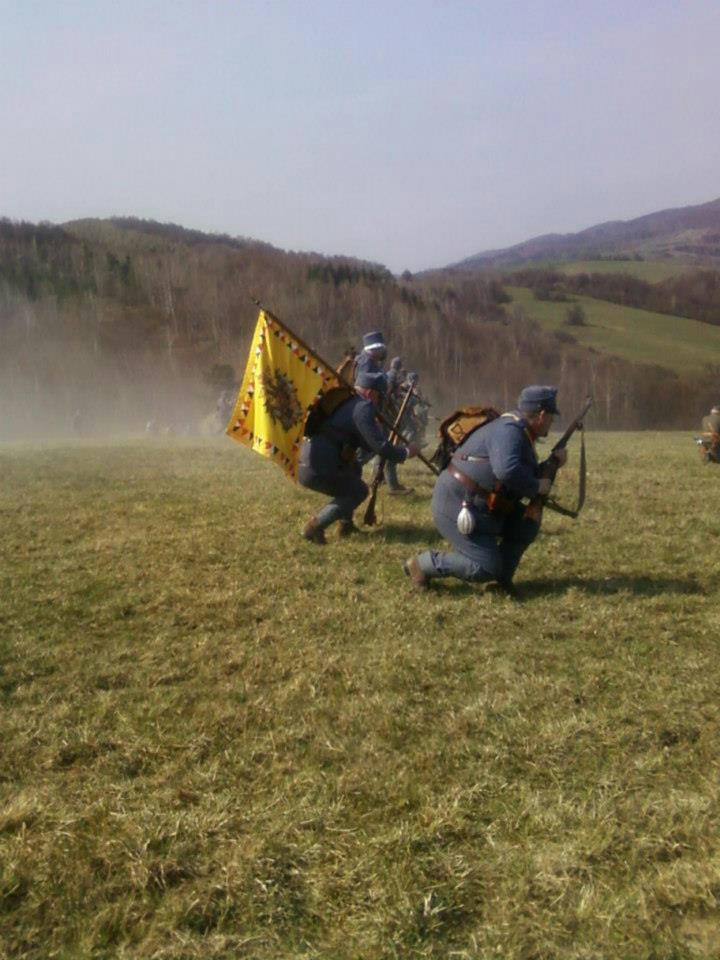
Austro-Hungarian soldiers with regimental flag routed from their main trenchline by Russian infantry, now fighting their way back
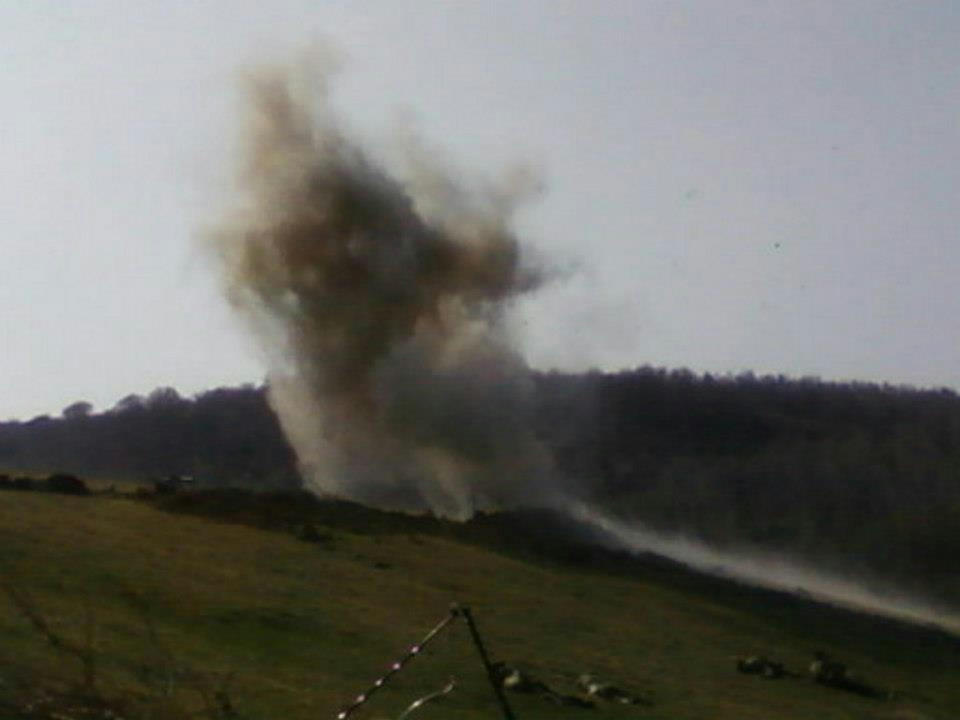
Shelling of Austro-Hungarian trenchlines by Russian artillery
MY OWN VIDEO
A PLAYLIST OF VIDEOS FROM THE EVENT
Article on the 2013 Výrava event
Article on WWI archaeological research in Výrava in the preceding years
Back in the spring of 1915, around Easter, the east Carpathians in modern day Slovakia saw some massive clashes between Austria-Hungary and Russia, after Russia launched the so-called "Easter Offensive". The events of those weeks would pass down into history and popular memory as "The Easter Battle". One of the many frontlines of this phase of fighting lay in the hills next to the village of Výrava in the modern day Medzilaborce district. And that's where this frankly impressive reenactment took place again, after 98 years... (See this Google Maps link for the location.)
----
International Museum Day, Zemplín Museum in Michalovce (17th May 2014)
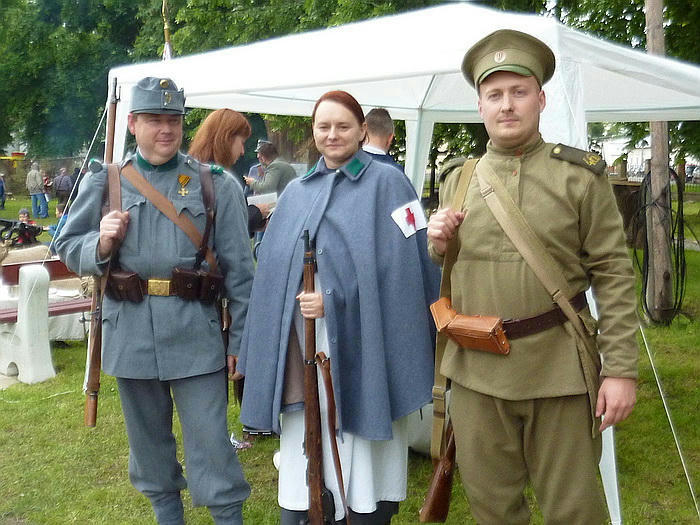
WWI reenactors (A-H soldier, A-H nurse, Russian soldier) at the WWI exhibit stalls on the museum's grounds
Field hospital medicines and equipment exhibit
Dressing a leg wound (of a captured Russian soldier)
A-H soldier and A-H machine gun nest exhibit
A-H soldier backpack with assorted field kit
Most of the reenactors seen at this event were from the Polish team "Group for Historical Reenactment Gorlice 1915". See also here, here and here.
This year's (i.e. 2014's) Open Doors Day at the Zemplín Museum (as part of the International Museum Day) was focused on commemorating the First World War centennary of this year. Most of the special events on the 17th of May focused on WWI related stuff. In addition to small-scale reenactments in the front yard and park of the museum, they also included the opening of a temporary exhibition, focusing on the veterans of WWI from Slovakia and their preserved written or oral accounts on their experiences in the war. The other, smaller venues were an exhibit of contemporary smaller military tech by the Prešov and Michalovce garissons, activities for families with kids, folklore group performances, a Ford T roadster display by a local vintage car collector, a small market and, last but not least, free entrance to all exhibits of the museum as part of Open Doors Day (as you usually pay a small fee).
----
Karpaty 1914/1915 Humenné (17th-18th October 2014)
Poster of the 2014 Humenné event (1)
Poster of the 2014 Humenné event (2)
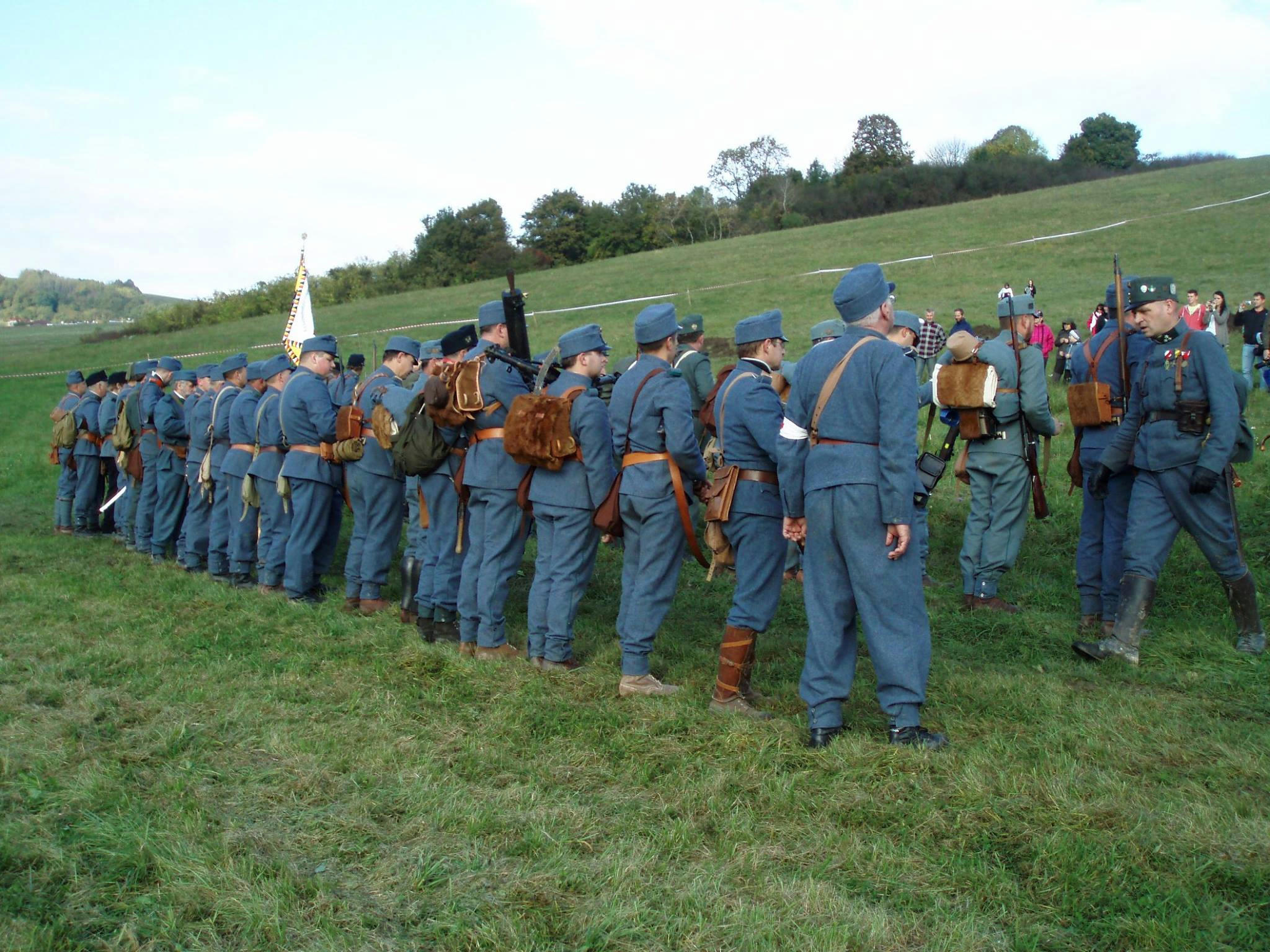
Austro-Hungarian soldiers assembling
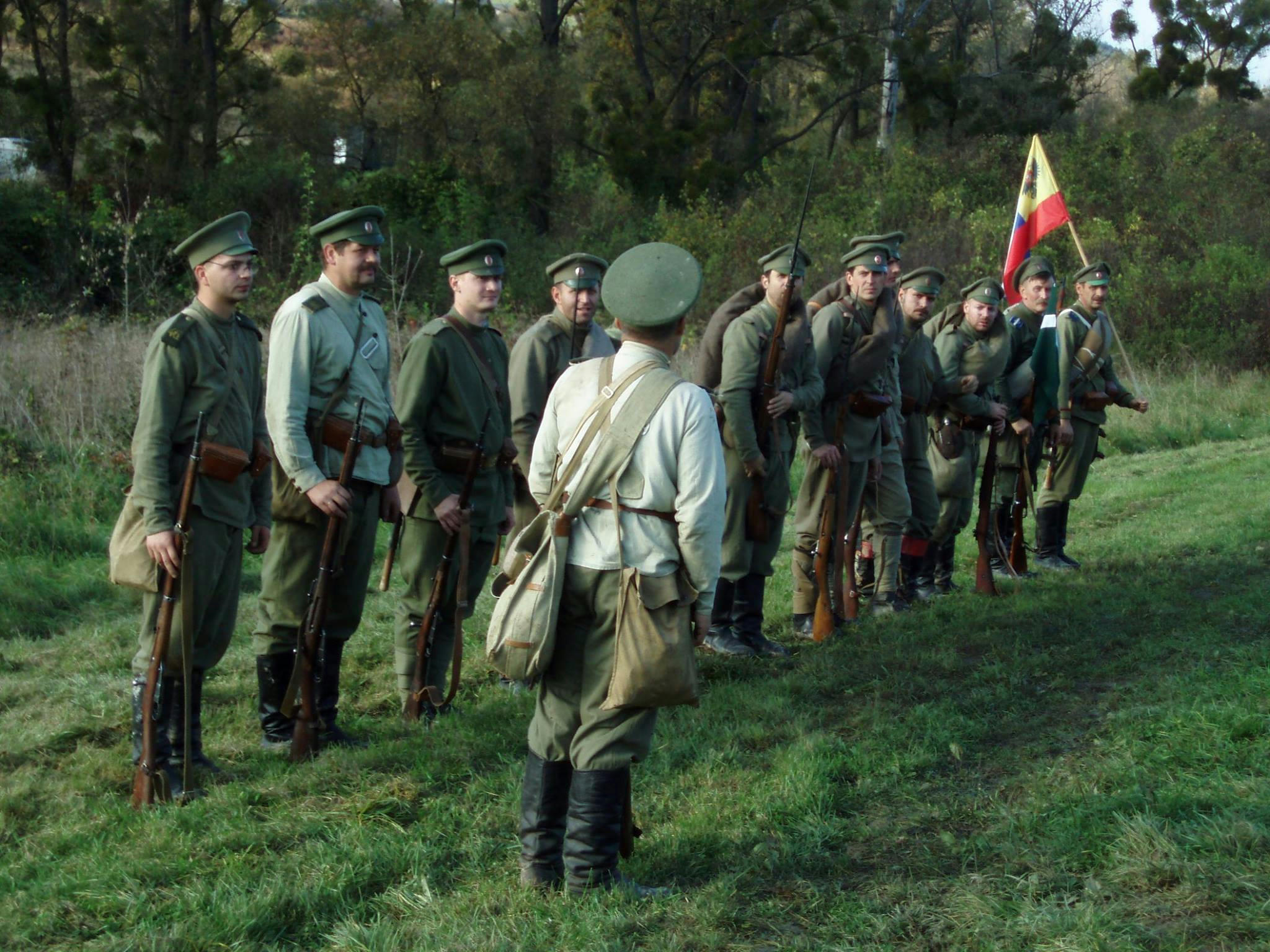
Russian soldiers assembling
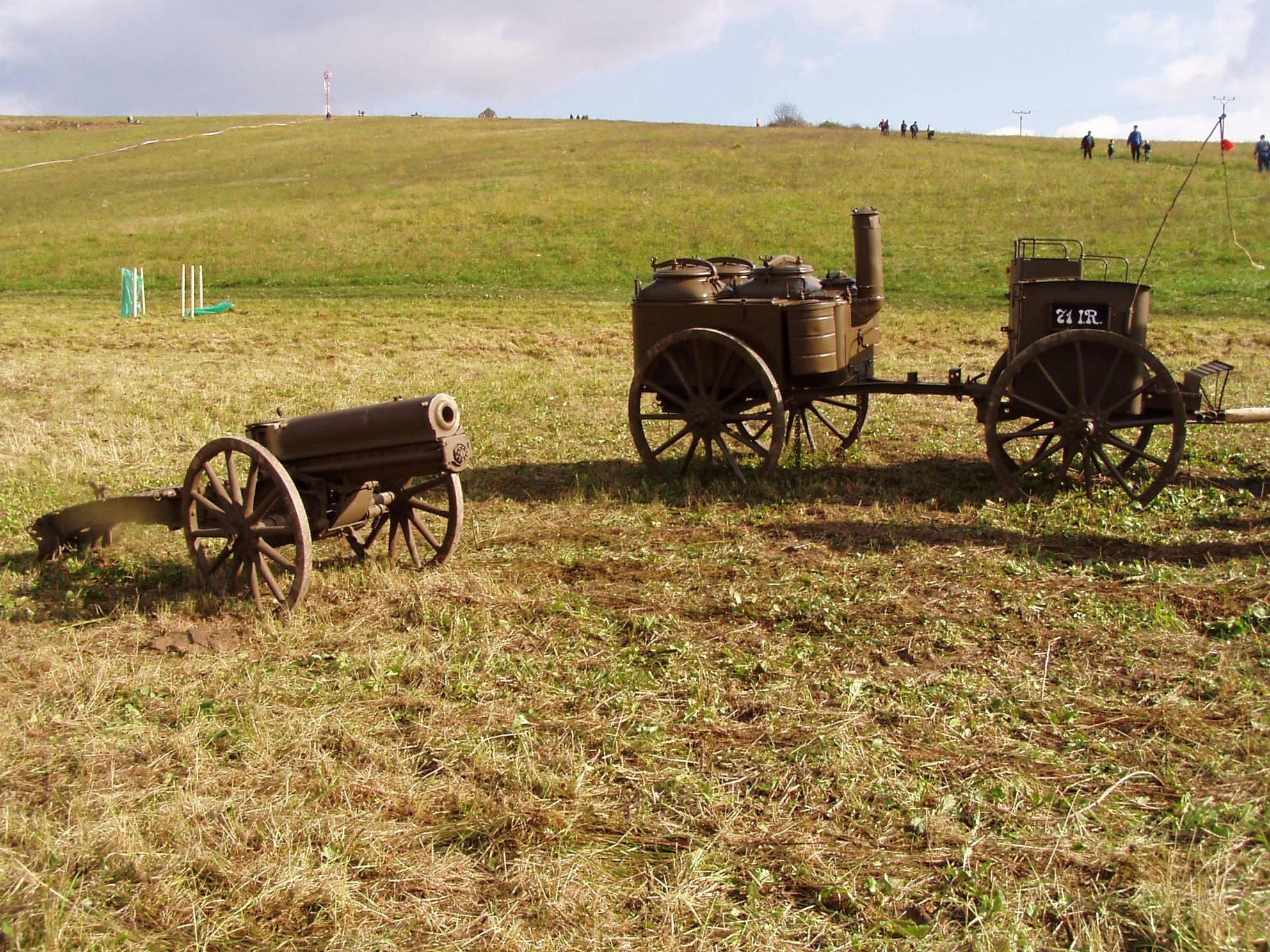
Austro-Hungarian Feldküche M.1905 modular field kitchen of the 71st Infantry Regiment and a Škoda 7.5 cm Gebirgskanone M.15
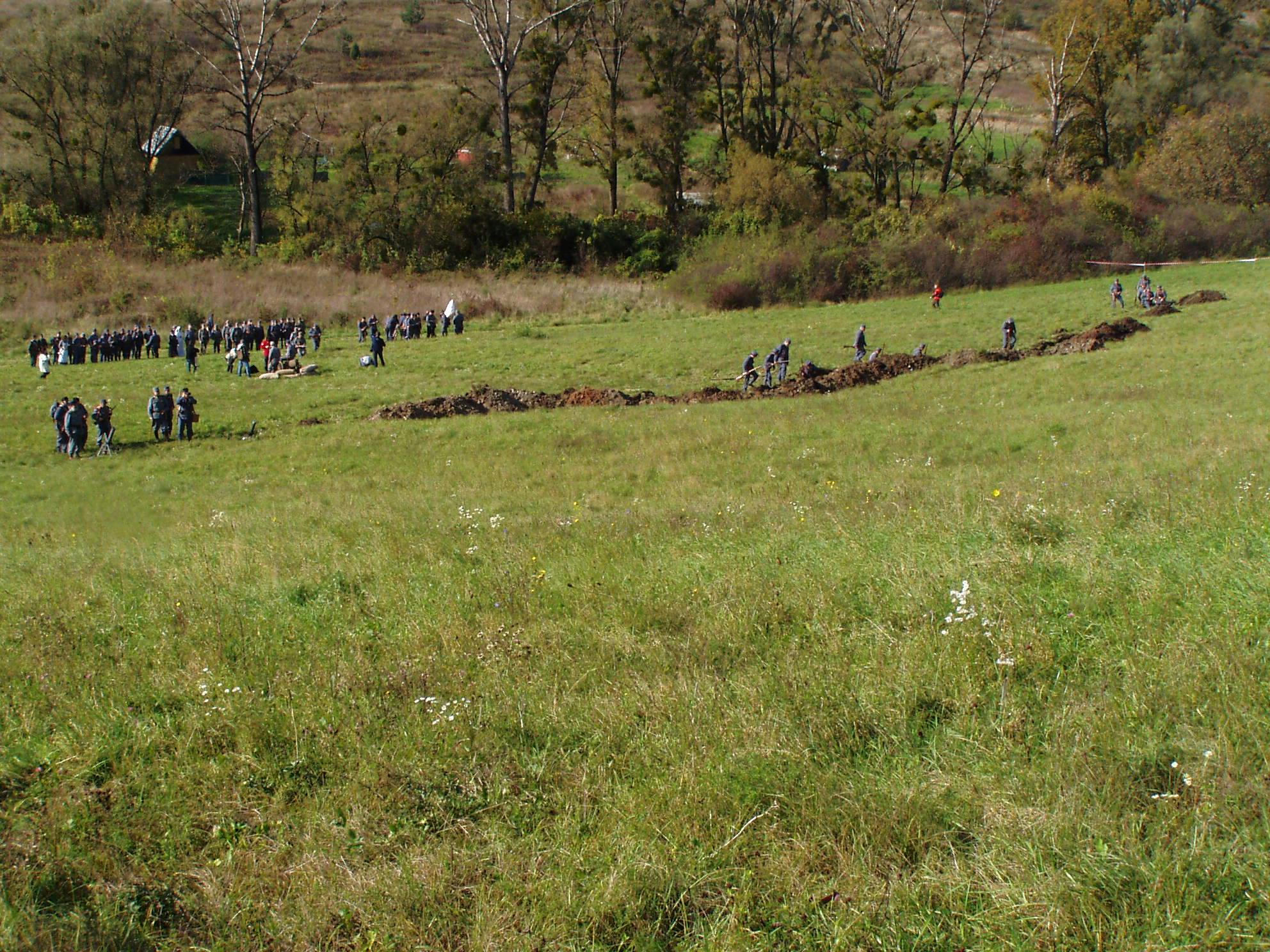
Austro-Hungarian trenches at the foot of the calvary hill, on its western hillside (the edge of town)
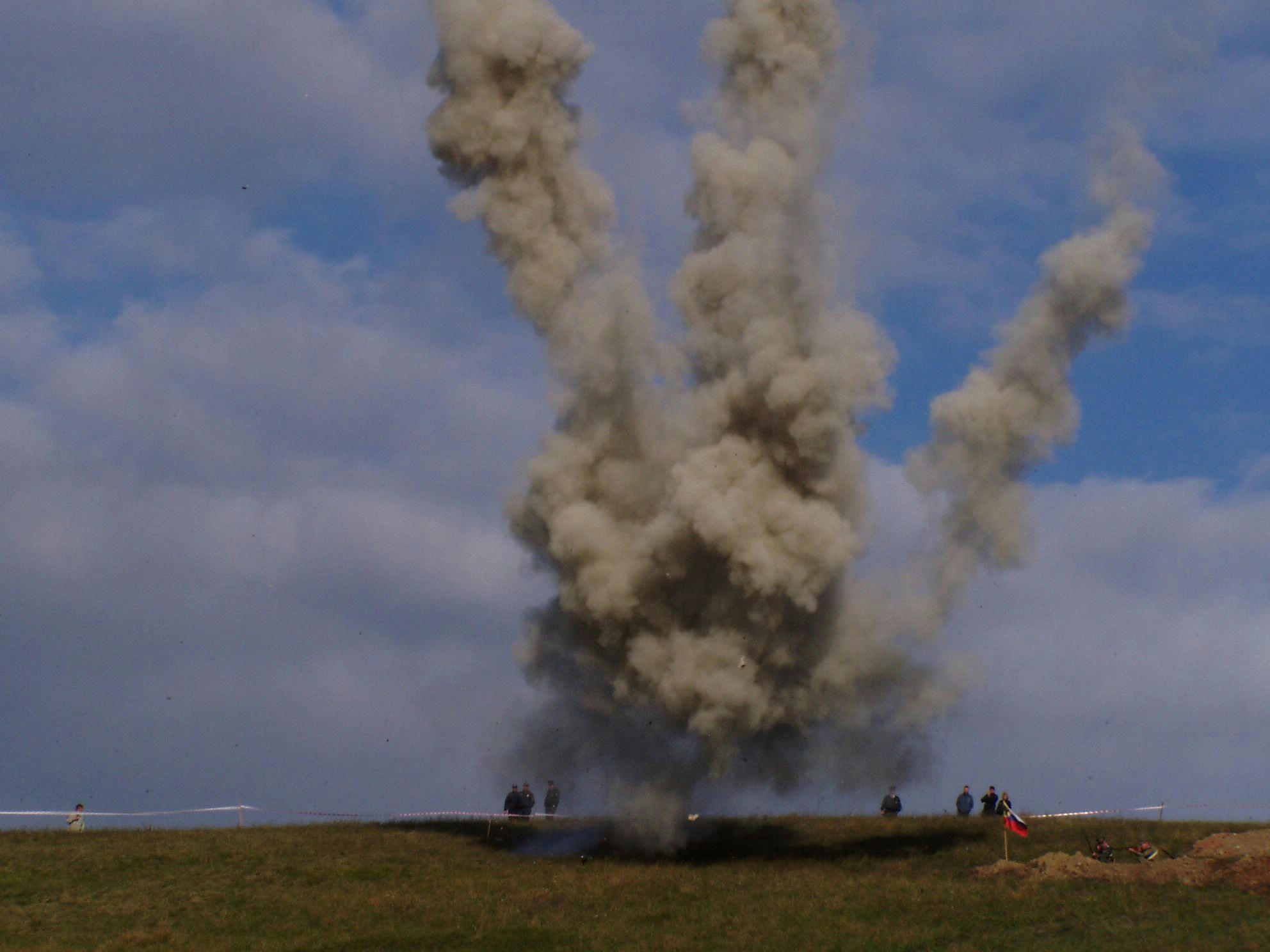
Shelling of the Russian trenches on the western ridge of the calvary hill
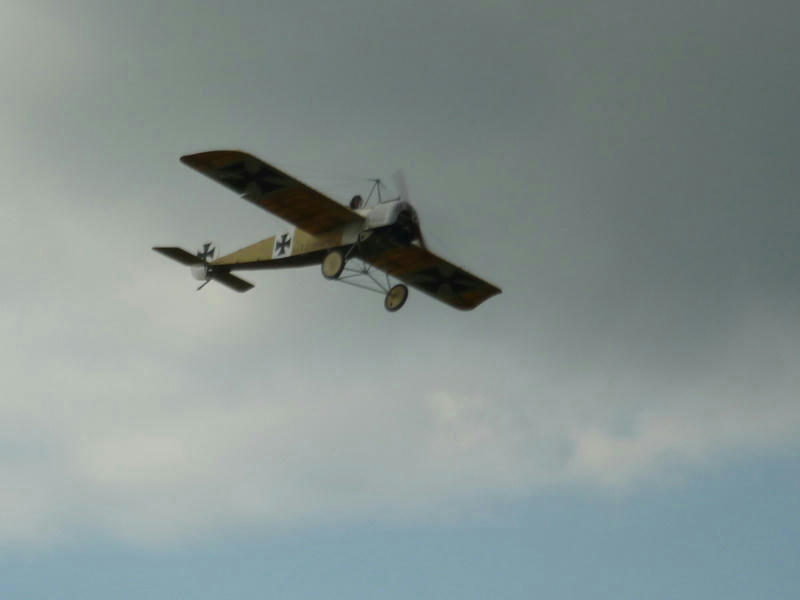
German soldiers of the expeditionary Beskidenkorps
Maxim MG 08 of the German expeditionary troops
The Škoda Gebirgskanone M.15
Officers being chummy
Russian mockup trenchline (upper end of the hill)
Austro-Hungarian mockup trenchline (foot of the hill)
Austro-Hungarian mockup trenches 1 and 2 and 3
Austro-Hungarian tent camp with provisions and gear
Austro-Hungarian Schwarzlose M.07 machine gun
Austro-Hungarian field hospital and medical supplies 1 and 2 and 3
Austro-Hungarian gun position with Škoda cannon
Russian soldiers resting (quiet before the storm)
Fokker buzzing above
Going prone...
An uphill battle...
Getting tactical...
Shot while advancing...
Austro-Hungarian wounded and dead
Austro-Hungarian soldiers carrying a stretcher
Austro-Hungarian nurses in action
Shelling continued...
Austro-Hungarian soldiers ascending the hill
Taking the contested calvary hill ridge
The hill retaken
Spectators on the hillside during the 2014 Karpaty 1914/1915 event
Austro-Hungarian regimental flag
Austro-Hungarian field kit on backpack, webbing and belt
Limbering the Škoda cannon back into a van
Reenactors packing
Russian honourable rifle salvo
Russian soldier who seems ISOTed to 2014
"In Tsarist Russia, anachronistic telephone calls you..."
KVH Beskydy promotional stall
Stall with Carpathian Front info panels from 2010 exhibition (1)
Stall with Carpathian Front info panels from 2010 exhibition (2)
Humenné calvary today - the calvary hill was contested in WWI fighting, but the calvary was undamaged
Humenné calvary today - memorial sign about the history of the calvary
MY OWN VIDEO
A PLAYLIST OF VIDEOS FROM THE EVENT
Article on the 2014 Humenné event
A hundred years ago, in autumn, tsarist forces had reached one of the westernmost tips of their penetration into Austro-Hungarian territory. It was the town of Humenné and its surroundings. Fought over several times by both sides during 1914 and 1915, Humenné would become one of the Slovak towns most affected by the wartime events and their aftermath, and would be immortalised as THE Slovak town with a World War I legacy. But back at the very start, just as the unusual tale was picking up steam, there was the Battle of the Calvary, taking place on a slope on the same hill as the town's calvary is on, literally just a few hundred meters from the calvary itself. A hundred years later, this reenactment tried to recreate and commemorate the events of those particular clashes in the early phase of the battles over the town between Austria-Hungary and Russia. (See this Google Maps link for the location.)
(Minor note: Though a replica Fokker E.III spotter monoplane took part in the reenactment, this was a thing of necessity, as there was no available airworthy replica of an Albatros B.II spotter biplane - which would have been more faithful to OTL events. The B.II scoutplanes were used from the improvised airfield in nearby Strážske, a horse racing track. This defunct airfield became the first military airfield in Slovakia's aviation history and the first in use during wartime. One of the Austro-Hungarian Albatrosses was shot down by Russians in the later months of fighting.)
----
The First World War: The Carpathian Front 1914-1915 (16th October - 20th December 2014)
2014-2015 exhibition - Welcome sign
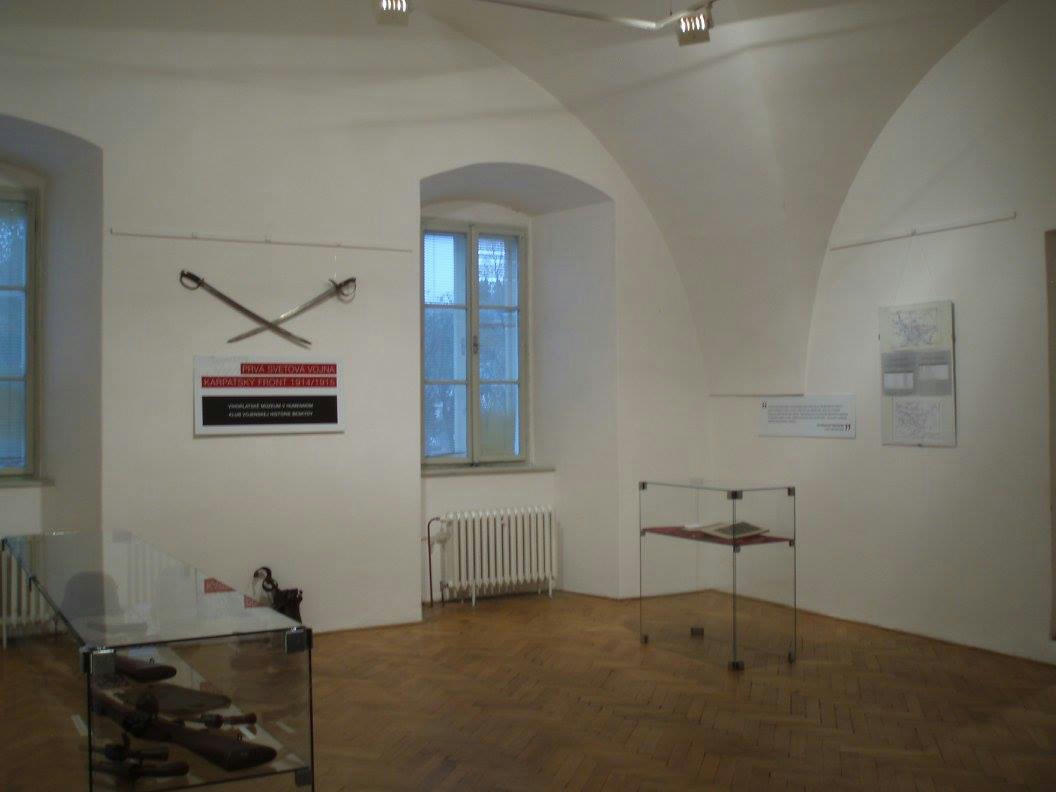
First room of the exhibition
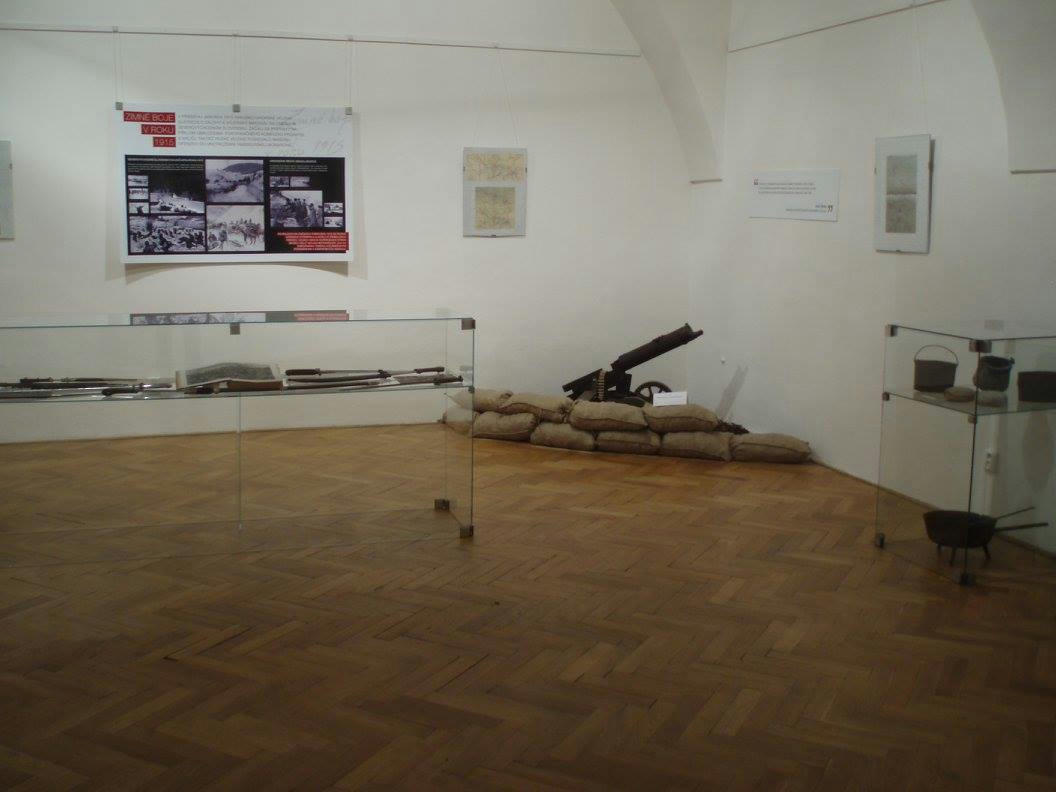
Second room of the exhibition
2014-2015 exhibit - Third room of the exhibition
2014-2015 exhibit - Screen with looping documentary footage in the third room
2014-2015 exhibit - Panel on the outbreak of WWI and the subsequent mobilization
2014-2015 exhibit - Military hats and pickelhaubes and documents
2015-2015 exhibit - Panel on the Carpathian Front of 1914/1915
2014-2015 exhibit - Panel on fighting in the Carpathians during the winter of 1914/1915
2014-2015 exhibit - Panel on the spring 1915 Easter Offensive and subsequent Easter Battle
2014-2015 exhibit - Period photograph viewer with magnifying lenses
2014-2015 exhibit - Panel on Carpathian Front statistics
2014-2015 exhibit - Panel on wartime property damage
2014-2015 exhibit - Panel on military cemeteries
That same day, I followed up the museum visit with a brief visit of the WWI cemetery in Humenné (one of the highest elevated subsections of the town's main cemetery).
2014 Humenné WWI cemetery visit - Main memorial plaque for the soldiers commemorated at Humenné's WWI cemetery
2014 Humenné WWI cemetery visit - The 1914-1918 WWI memorial, centrepiece of the Humenné WWI cemetery
2014 Humenné WWI cemetery visit - Graves of Austro-Hungarian and German soldiers at the Humenné WWI cemetery
2014 Humenné WWI cemetery visit - Graves of Austro-Hungarian and German soldiers at the Humenné WWi cemetery
2014 Humenné WWI cemetery visit - The grave of a former Czechoslovak Legionnaire at the edge of the WWI cemetery
For years, the Humenné cemetery was one of the few WWI cemeteries in east Slovakia and Slovakia in general that was in good condition. After KVH Beskydy worked on the restoration of all rural WWI cemeteries in the northeast during the late 2000s and the 2010s, it is now just one of many fully-functional WWI cemeteries in the northeast of the country, and probably the only urban one.
Vihorlat Museum news release on the 2014-2015 exhibition
This was the major temporary exhibition to commemorate the centennary of the first world war in east Slovakia. Once again, the Vihorlat Museum housed it, after developing it in cooperation with KVH Beskydy, but this was a much larger exhibition, taking up much of the three largest exhibit rooms in the upper storey of the museum's east wing. Interestingly enough, due to high interest and demand, it was prolonged after Christmas for the whole of January and only closed in early February 2015. I got to see it twice, though only by lucky accident in the latter case.
----
The Carpathian Winter 1914/1915 (22nd January - 13th March 2015)
Poster of the 2015 exhibition
Video of the exhibition opening
Article on the 2015 exhibition
This was a smaller, follow-up exhibition to the aforementioned big one, also temporary. Mostly photo and text based, and organised primarily by KVH Beskydy in their rented rooms and office in the Vihorlat Museum. As the name implies, it focused on the fighting in the Carpathians during the winter of 1914/1915. Due to one of the coldest winters in decades, the combatants on this front faced exceptionally freezing and harsh conditions, probably only surpassed during the entire war by the infamous battles high up in the Alps.
----
Karpaty 1914/1915 Hostovice (28th May 2016)
Poster of the Hostovice 2016 event
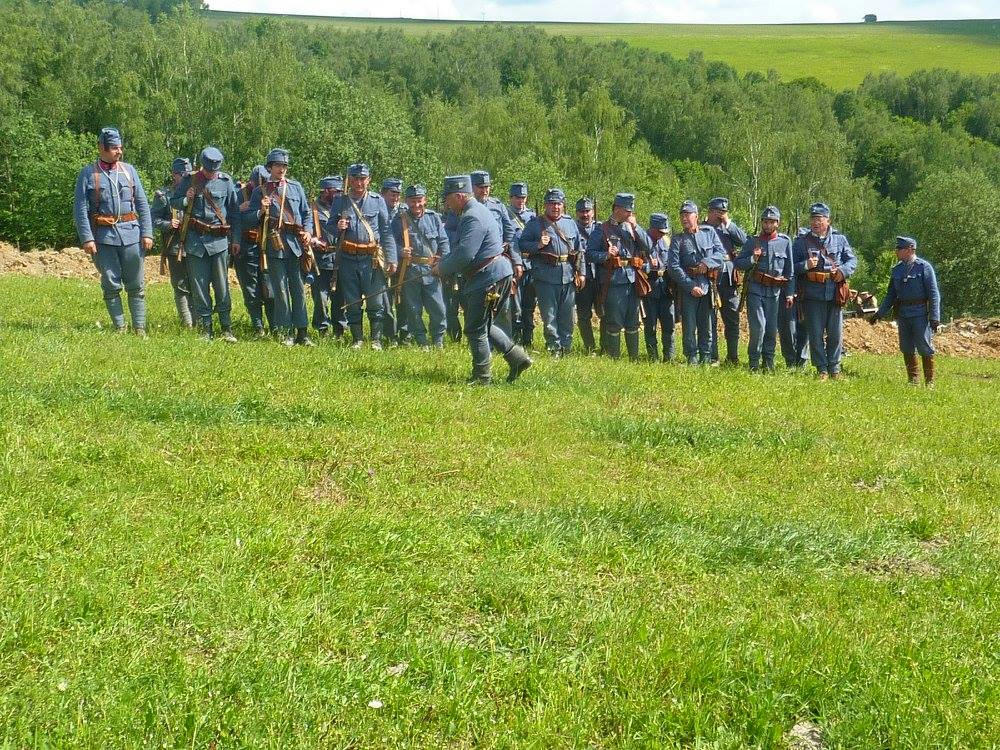
Austro-Hungarian soldiers assembling
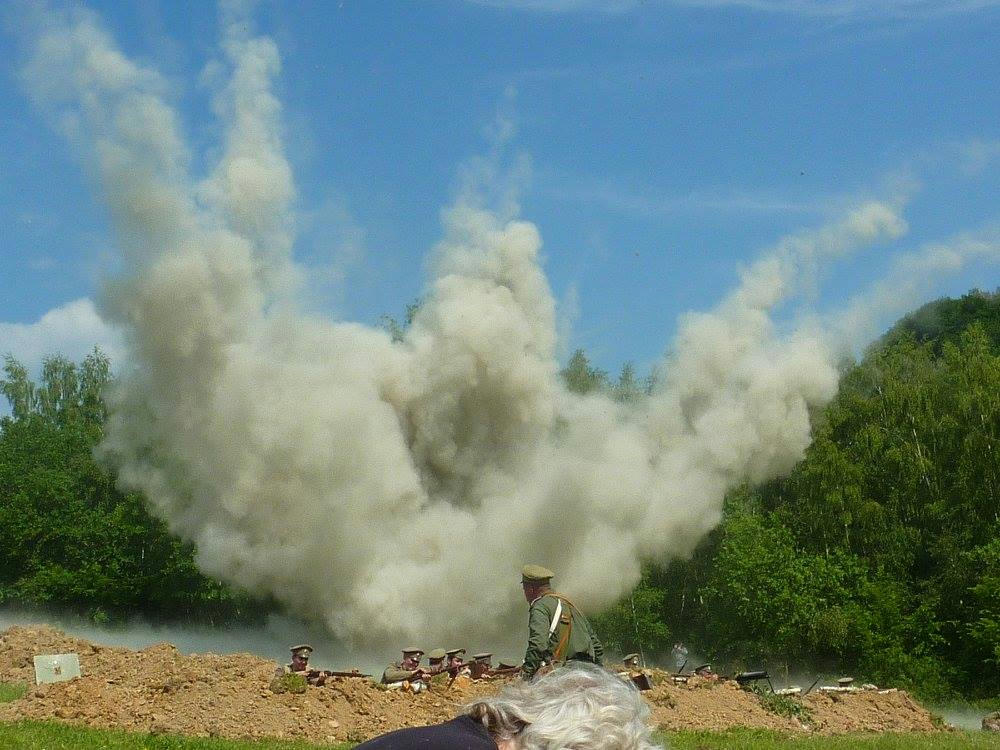
Russian trenches getting shelled with mortars and artillery
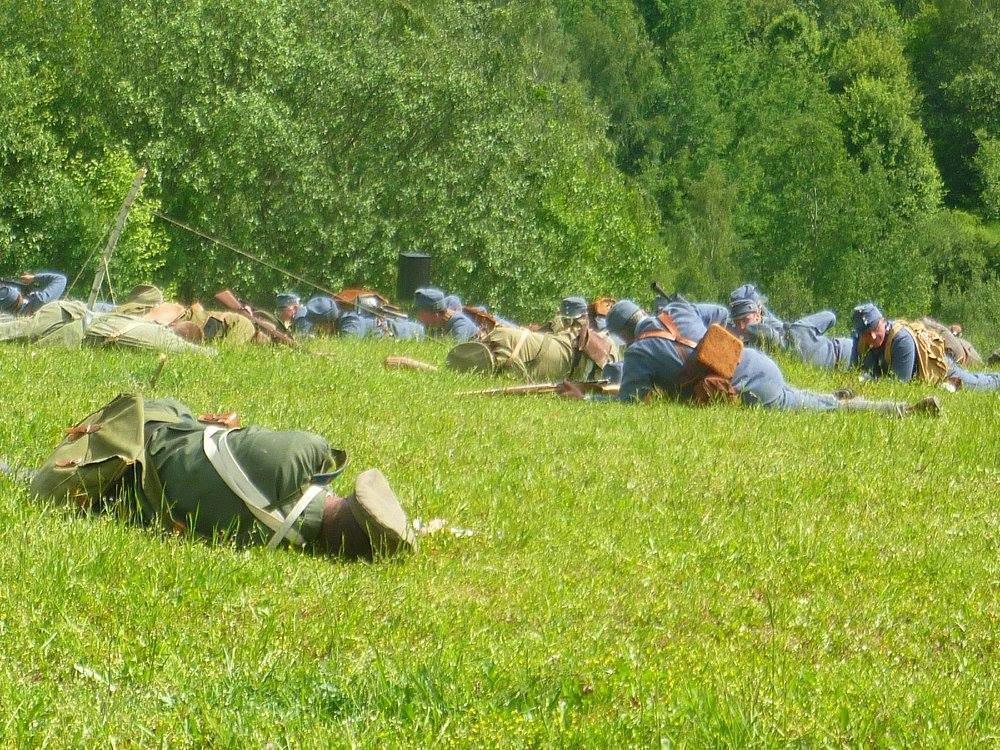
Fallen Russian infantrymen and Austro-Hungarian infantry advancing prone
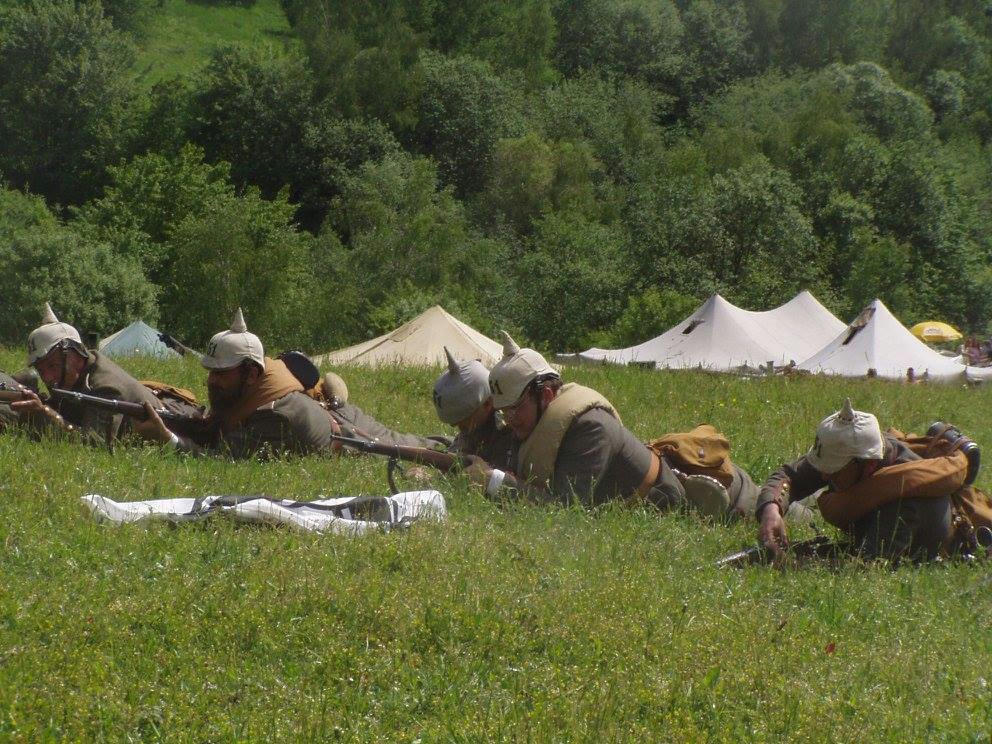
Allied soldiers from the German Empire's expeditionary troops (the Beskidenkorps) sent to Austria-Hungary's Carpathian front
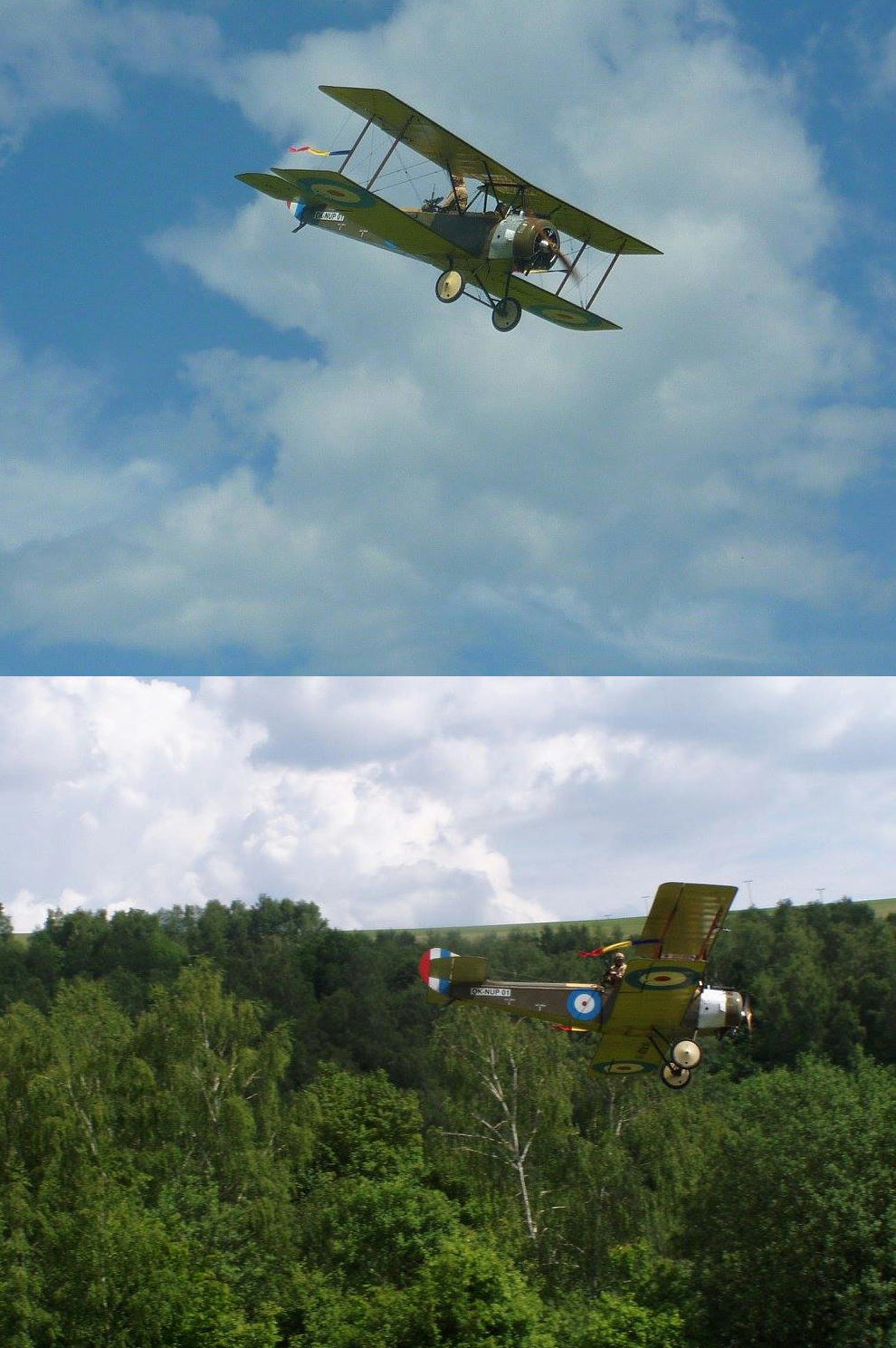
Flyworthy replica Sopwith Strutter portraying Russian imperial biplane. (The biplane photo is a collage of two photos into one image.)
Tents of the Austro-Hungarian army camp
Austro-Hungarian artillery position
Russian MG nest in the trenches
MY OWN VIDEO
A PLAYLIST OF VIDEOS FROM THE EVENT
Article on the 2016 Hostovice event
This battle in the environs to the east of the village of Hostovice was another part of the fighting during the Easter Offensive. Over a hundred years later, this sixth edition of the annual WWI reenactment took place close to the former trench lines and impromptu fortifications contested by both Russian and Austro-Hungarian forces. (See this Google Maps link for the location.)
(Minor note: Though a Sopwith Strutter spotter biplane took part in the reenactment, this was a thing of necessity, as there was no available airworthy replica of a Russian Imperial Air Force biplane of French or Russian manufacture - which would have, obviously, been more faithful to OTL events.)
----
Well, I hope you'll enjoy the photos and all the supplemental material I've tried to add. If you have any closer questions regarding the content, feel free to ask me.
If you have any closer questions regarding the content, feel free to ask me.  Also, please let me know if all of the linking's working correctly.
Also, please let me know if all of the linking's working correctly.
----
2021 addendum: I did not visit the 2012 reenactment in Nižná Polianka, the 2015 reenactment in Stebník, the 2017 reenactment in Nižná Polianka or the 2018 reenactment in Medzilaborce, but if you click these preceding links, you'll see the video playlists from these four reenactment events, if you're interested. (There is also a news article on the 2015 event and a news archive photogallery of the 2018 event. Here's an article on a KVH Beskydy research conference from early 2017, which summed up and presented some of the interesting new research finds in primary sources made in the preceding years. I also find it really amusing that it's only been now in spring 2021 that I discovered a news article from 2015 about the coming 2015 re-enactment used my own Výrava docu-video as a showcase.
 )
)
----
Important final note: The sample photos and videos from my photo/video collection I share here are free to view, but these photos are not free to be shared, spread or be otherwise used outside of this thread, edited or unedited, without my explicit personal permission.
If you want any more photos from my albums of these exhibitions and living history events commemorating WWI's eastern front, please send me a PM and we can arrange a deal. Note that I will only share these sample photos and further photos on a strictly "personal use" basis. They are NOT in the public domain, or creative commons or share-alike.
Until anything changes and unless anything changes and I give my official go-ahead and licensing permission in this thread, no one on AH.com or elsewhere is allowed to share these photos with other people. Furthermore, no one is allowed to present these photos (or the photos I might send to those interested) as their own works, and this rule also extends to the videos I have personally made. Even if there are some developments in the future, such as me sharing some of my select photos online via a specific license - such as on Wikimedia Commons, etc. - it will still be a license which will require citing me as an author, proper attribution, etc. I will also consider the attribution to the event/exhibition the photo was taken at, including the month and year, to be important. If one also provides attribution for the event/exhibition organizer (in this case, mostly the KVH Beskydy historical society) and participants (reenactor groups, museum institutions) to be a good move by anyone doing the necessary attribution. However, until I explicitly say you can share particular specific photos from my collections, along with the necessary attributions, sharing them online without my permission (even if you provide attribution) will be considered a breach of my personal copyright.
I do not claim any sort of ownership over the videos that are not my own. Those are provided for informational and archival purposes only.
Finally, the reason I provide these photos and videos to the AH.com community is twofold:
- to preserve my earlier documenting of WWI commemoration events from several years ago
- to provide some WWI reference material and visual inspiration for AH.com writers eyeing the era of the First World War, but not satisfied with only black-and-white photos of some of its more obscure theatres and fronts
This thread also includes the contents of another older thread, originally posted on the 8th of May 2013, which was a brief report on my stay at one of the WWI battlefield reenactment events I am sharing in this new and definitive version of the compilation thread.
The only contents of the former two threads I am preserving in this new thread are longer posts by me. I am not copying and will not copy any feedback posts of other board members made in the two original versions of these older threads.
----
Here are my own photos from all the WWI commemoration events that I have attended thus far during this decade, particularly during the last three years. Here's the overview, starting with the oldest event and ending with the latest... Click the spoilers to see photos.
----
The Carpathian Front 1914-1915: Uncovering the Past (11th November - 31st December 2010)
Poster of the 2010 exhibition
2010 exhibit - KVH Beskydy and their activities
2010 exhibit - KVH Beskydy and their publications
2010 exhibit - Panel on the 1914-1915 Carpathian Front
2010 exhibit - Panel on soldier life on the Carpathian Front
2010 exhibit - Panel on Humenné during the fighting of 1914
2010 exhibit - Panel on the impacts of WWI on the town of Humenné
2010 exhibit - Panel on military cemeteries of the first world war
2010 exhibit - Panel on the salvaging and restoration of WWI military cemeteries in Slovakia
2010 exhibit - Photo gallery panel of WWI cemetery restorations by KVH Beskydy research team and volunteers
2010 exhibit - Russian soldier uniform and kit
2010 exhibit - Austro-Hungarian and Russian sabre
2010 exhibit - Austro-Hungarian and Russian rifles (detail left, Mosin-Nagant (above) and Steyr-Männlicher (below); detail right, Werndl rifles)
2010 exhibit - Lantern and bayonets
2010 exhibit - Bladed weapons
2010 exhibit - Cooking utensils
2010 exhibit - Medals
2010 exhibit - KVH Beskydy and their publications
2010 exhibit - Panel on the 1914-1915 Carpathian Front
2010 exhibit - Panel on soldier life on the Carpathian Front
2010 exhibit - Panel on Humenné during the fighting of 1914
2010 exhibit - Panel on the impacts of WWI on the town of Humenné
2010 exhibit - Panel on military cemeteries of the first world war
2010 exhibit - Panel on the salvaging and restoration of WWI military cemeteries in Slovakia
2010 exhibit - Photo gallery panel of WWI cemetery restorations by KVH Beskydy research team and volunteers
2010 exhibit - Russian soldier uniform and kit
2010 exhibit - Austro-Hungarian and Russian sabre
2010 exhibit - Austro-Hungarian and Russian rifles (detail left, Mosin-Nagant (above) and Steyr-Männlicher (below); detail right, Werndl rifles)
2010 exhibit - Lantern and bayonets
2010 exhibit - Bladed weapons
2010 exhibit - Cooking utensils
2010 exhibit - Medals
A fairly small (single-room), pre-centennary temporary exhibition in the Vihorlat Museum in Humenné. Organised in late autumn and winter of 2010, in close cooperation with the historical research and heritage association Klub vojenskej histórie Beskydy (Club of Military History Beskydy) from the same town. (You can find their older website archived here, the new website is currently being worked on.)
----
Karpaty 1914/1915 Výrava (20th April 2013)
Poster of the 2013 Výrava event (1)
Poster of the 2013 Výrava event (2)

Educational trail above Výrava, to the local WWI cemetery. This sign is about the Easter Battle of 1915, close-up on map here.

Austro-Hungarian artillery (the artillery piece seems similar to a 7 cm Gebirgskanone M.99)

Reenactors resting, quiet before the storm

Austro-Hungarian soldiers and some allied German expeditionary soldiers in their uphill trenches, with regimental flag

Austro-Hungarian soldiers with regimental flag routed from their main trenchline by Russian infantry, now fighting their way back

Shelling of Austro-Hungarian trenchlines by Russian artillery
A PLAYLIST OF VIDEOS FROM THE EVENT
Article on the 2013 Výrava event
Article on WWI archaeological research in Výrava in the preceding years
Back in the spring of 1915, around Easter, the east Carpathians in modern day Slovakia saw some massive clashes between Austria-Hungary and Russia, after Russia launched the so-called "Easter Offensive". The events of those weeks would pass down into history and popular memory as "The Easter Battle". One of the many frontlines of this phase of fighting lay in the hills next to the village of Výrava in the modern day Medzilaborce district. And that's where this frankly impressive reenactment took place again, after 98 years... (See this Google Maps link for the location.)
----
International Museum Day, Zemplín Museum in Michalovce (17th May 2014)

WWI reenactors (A-H soldier, A-H nurse, Russian soldier) at the WWI exhibit stalls on the museum's grounds
Field hospital medicines and equipment exhibit
Dressing a leg wound (of a captured Russian soldier)
A-H soldier and A-H machine gun nest exhibit
A-H soldier backpack with assorted field kit
Most of the reenactors seen at this event were from the Polish team "Group for Historical Reenactment Gorlice 1915". See also here, here and here.
This year's (i.e. 2014's) Open Doors Day at the Zemplín Museum (as part of the International Museum Day) was focused on commemorating the First World War centennary of this year. Most of the special events on the 17th of May focused on WWI related stuff. In addition to small-scale reenactments in the front yard and park of the museum, they also included the opening of a temporary exhibition, focusing on the veterans of WWI from Slovakia and their preserved written or oral accounts on their experiences in the war. The other, smaller venues were an exhibit of contemporary smaller military tech by the Prešov and Michalovce garissons, activities for families with kids, folklore group performances, a Ford T roadster display by a local vintage car collector, a small market and, last but not least, free entrance to all exhibits of the museum as part of Open Doors Day (as you usually pay a small fee).
----
Karpaty 1914/1915 Humenné (17th-18th October 2014)
Poster of the 2014 Humenné event (1)
Poster of the 2014 Humenné event (2)

Austro-Hungarian soldiers assembling

Russian soldiers assembling

Austro-Hungarian Feldküche M.1905 modular field kitchen of the 71st Infantry Regiment and a Škoda 7.5 cm Gebirgskanone M.15

Austro-Hungarian trenches at the foot of the calvary hill, on its western hillside (the edge of town)

Shelling of the Russian trenches on the western ridge of the calvary hill

German soldiers of the expeditionary Beskidenkorps
Maxim MG 08 of the German expeditionary troops
The Škoda Gebirgskanone M.15
Officers being chummy
Russian mockup trenchline (upper end of the hill)
Austro-Hungarian mockup trenchline (foot of the hill)
Austro-Hungarian mockup trenches 1 and 2 and 3
Austro-Hungarian tent camp with provisions and gear
Austro-Hungarian Schwarzlose M.07 machine gun
Austro-Hungarian field hospital and medical supplies 1 and 2 and 3
Austro-Hungarian gun position with Škoda cannon
Russian soldiers resting (quiet before the storm)
Fokker buzzing above
Going prone...
An uphill battle...
Getting tactical...
Shot while advancing...
Austro-Hungarian wounded and dead
Austro-Hungarian soldiers carrying a stretcher
Austro-Hungarian nurses in action
Shelling continued...
Austro-Hungarian soldiers ascending the hill
Taking the contested calvary hill ridge
The hill retaken
Spectators on the hillside during the 2014 Karpaty 1914/1915 event
Austro-Hungarian regimental flag
Austro-Hungarian field kit on backpack, webbing and belt
Limbering the Škoda cannon back into a van
Reenactors packing
Russian honourable rifle salvo
Russian soldier who seems ISOTed to 2014
"In Tsarist Russia, anachronistic telephone calls you..."
KVH Beskydy promotional stall
Stall with Carpathian Front info panels from 2010 exhibition (1)
Stall with Carpathian Front info panels from 2010 exhibition (2)
Humenné calvary today - the calvary hill was contested in WWI fighting, but the calvary was undamaged
Humenné calvary today - memorial sign about the history of the calvary
A PLAYLIST OF VIDEOS FROM THE EVENT
Article on the 2014 Humenné event
A hundred years ago, in autumn, tsarist forces had reached one of the westernmost tips of their penetration into Austro-Hungarian territory. It was the town of Humenné and its surroundings. Fought over several times by both sides during 1914 and 1915, Humenné would become one of the Slovak towns most affected by the wartime events and their aftermath, and would be immortalised as THE Slovak town with a World War I legacy. But back at the very start, just as the unusual tale was picking up steam, there was the Battle of the Calvary, taking place on a slope on the same hill as the town's calvary is on, literally just a few hundred meters from the calvary itself. A hundred years later, this reenactment tried to recreate and commemorate the events of those particular clashes in the early phase of the battles over the town between Austria-Hungary and Russia. (See this Google Maps link for the location.)
(Minor note: Though a replica Fokker E.III spotter monoplane took part in the reenactment, this was a thing of necessity, as there was no available airworthy replica of an Albatros B.II spotter biplane - which would have been more faithful to OTL events. The B.II scoutplanes were used from the improvised airfield in nearby Strážske, a horse racing track. This defunct airfield became the first military airfield in Slovakia's aviation history and the first in use during wartime. One of the Austro-Hungarian Albatrosses was shot down by Russians in the later months of fighting.)
----
The First World War: The Carpathian Front 1914-1915 (16th October - 20th December 2014)
2014-2015 exhibition - Welcome sign

First room of the exhibition

Second room of the exhibition
2014-2015 exhibit - Third room of the exhibition
2014-2015 exhibit - Screen with looping documentary footage in the third room
2014-2015 exhibit - Panel on the outbreak of WWI and the subsequent mobilization
2014-2015 exhibit - Military hats and pickelhaubes and documents
2015-2015 exhibit - Panel on the Carpathian Front of 1914/1915
2014-2015 exhibit - Panel on fighting in the Carpathians during the winter of 1914/1915
2014-2015 exhibit - Panel on the spring 1915 Easter Offensive and subsequent Easter Battle
2014-2015 exhibit - Period photograph viewer with magnifying lenses
2014-2015 exhibit - Panel on Carpathian Front statistics
- the fighting in northeast Slovakia lasted for 5 months and 2 weeks
- 6 modern day districts were affected by WWI frontline fighting
- ca 30 000 dead in total
- only 5 000 dead combatants were identified by name
- ca 250 000 wounded and missing in action
- more than 200 military cemeteries built as a result of the wartime deaths
- the largest military cemetery in the village of Veľkrop contains the remains of 8662 fallen soldiers
2014-2015 exhibit - Panel on wartime property damage
2014-2015 exhibit - Panel on military cemeteries
That same day, I followed up the museum visit with a brief visit of the WWI cemetery in Humenné (one of the highest elevated subsections of the town's main cemetery).
2014 Humenné WWI cemetery visit - Main memorial plaque for the soldiers commemorated at Humenné's WWI cemetery
2014 Humenné WWI cemetery visit - The 1914-1918 WWI memorial, centrepiece of the Humenné WWI cemetery
2014 Humenné WWI cemetery visit - Graves of Austro-Hungarian and German soldiers at the Humenné WWI cemetery
2014 Humenné WWI cemetery visit - Graves of Austro-Hungarian and German soldiers at the Humenné WWi cemetery
2014 Humenné WWI cemetery visit - The grave of a former Czechoslovak Legionnaire at the edge of the WWI cemetery
For years, the Humenné cemetery was one of the few WWI cemeteries in east Slovakia and Slovakia in general that was in good condition. After KVH Beskydy worked on the restoration of all rural WWI cemeteries in the northeast during the late 2000s and the 2010s, it is now just one of many fully-functional WWI cemeteries in the northeast of the country, and probably the only urban one.
This was the major temporary exhibition to commemorate the centennary of the first world war in east Slovakia. Once again, the Vihorlat Museum housed it, after developing it in cooperation with KVH Beskydy, but this was a much larger exhibition, taking up much of the three largest exhibit rooms in the upper storey of the museum's east wing. Interestingly enough, due to high interest and demand, it was prolonged after Christmas for the whole of January and only closed in early February 2015. I got to see it twice, though only by lucky accident in the latter case.
----
The Carpathian Winter 1914/1915 (22nd January - 13th March 2015)
Poster of the 2015 exhibition
2015 exhibit - KVH Beskydy promotional sign
2015 exhibit - KVH Beskydy office and exhibition space at the Vihorlat Museum in Humenné
2015 exhibit - Smaller panel on the subject "Terrain"
2015 exhibit - Smaller panel on the subject "Weather"
2015 exhibit - Smaller panel on the subject "Soldiers"
2015 exhibit - Smaller panel on the subject "Commanders"
2015 exhibit - Smaller panel on the subject "Fighting"
2015 exhibit - Smaller panel on the subject "Resupply"
2015 exhibit - Big panel on the 1914-1915 Carpathian Front
2015 exhibit - Big panel on WWI military cemeteries
2015 exhibit - Entrenching and engineering tools
2015 exhibit - Guns, ammunition and bayonets
2015 exhibit - General information panel on the 1914-1915 Carpathian Front
2015 exhibit - KVH Beskydy office and exhibition space at the Vihorlat Museum in Humenné
2015 exhibit - Smaller panel on the subject "Terrain"
2015 exhibit - Smaller panel on the subject "Weather"
2015 exhibit - Smaller panel on the subject "Soldiers"
2015 exhibit - Smaller panel on the subject "Commanders"
2015 exhibit - Smaller panel on the subject "Fighting"
2015 exhibit - Smaller panel on the subject "Resupply"
2015 exhibit - Big panel on the 1914-1915 Carpathian Front
2015 exhibit - Big panel on WWI military cemeteries
2015 exhibit - Entrenching and engineering tools
2015 exhibit - Guns, ammunition and bayonets
2015 exhibit - General information panel on the 1914-1915 Carpathian Front
Article on the 2015 exhibition
This was a smaller, follow-up exhibition to the aforementioned big one, also temporary. Mostly photo and text based, and organised primarily by KVH Beskydy in their rented rooms and office in the Vihorlat Museum. As the name implies, it focused on the fighting in the Carpathians during the winter of 1914/1915. Due to one of the coldest winters in decades, the combatants on this front faced exceptionally freezing and harsh conditions, probably only surpassed during the entire war by the infamous battles high up in the Alps.
----
Karpaty 1914/1915 Hostovice (28th May 2016)
Poster of the Hostovice 2016 event

Austro-Hungarian soldiers assembling

Russian trenches getting shelled with mortars and artillery

Fallen Russian infantrymen and Austro-Hungarian infantry advancing prone

Allied soldiers from the German Empire's expeditionary troops (the Beskidenkorps) sent to Austria-Hungary's Carpathian front

Flyworthy replica Sopwith Strutter portraying Russian imperial biplane. (The biplane photo is a collage of two photos into one image.)
Tents of the Austro-Hungarian army camp
Austro-Hungarian artillery position
Russian MG nest in the trenches
A PLAYLIST OF VIDEOS FROM THE EVENT
Article on the 2016 Hostovice event
This battle in the environs to the east of the village of Hostovice was another part of the fighting during the Easter Offensive. Over a hundred years later, this sixth edition of the annual WWI reenactment took place close to the former trench lines and impromptu fortifications contested by both Russian and Austro-Hungarian forces. (See this Google Maps link for the location.)
(Minor note: Though a Sopwith Strutter spotter biplane took part in the reenactment, this was a thing of necessity, as there was no available airworthy replica of a Russian Imperial Air Force biplane of French or Russian manufacture - which would have, obviously, been more faithful to OTL events.)
----
Well, I hope you'll enjoy the photos and all the supplemental material I've tried to add.
----
2021 addendum: I did not visit the 2012 reenactment in Nižná Polianka, the 2015 reenactment in Stebník, the 2017 reenactment in Nižná Polianka or the 2018 reenactment in Medzilaborce, but if you click these preceding links, you'll see the video playlists from these four reenactment events, if you're interested. (There is also a news article on the 2015 event and a news archive photogallery of the 2018 event. Here's an article on a KVH Beskydy research conference from early 2017, which summed up and presented some of the interesting new research finds in primary sources made in the preceding years. I also find it really amusing that it's only been now in spring 2021 that I discovered a news article from 2015 about the coming 2015 re-enactment used my own Výrava docu-video as a showcase.
----
Important final note: The sample photos and videos from my photo/video collection I share here are free to view, but these photos are not free to be shared, spread or be otherwise used outside of this thread, edited or unedited, without my explicit personal permission.
If you want any more photos from my albums of these exhibitions and living history events commemorating WWI's eastern front, please send me a PM and we can arrange a deal. Note that I will only share these sample photos and further photos on a strictly "personal use" basis. They are NOT in the public domain, or creative commons or share-alike.
Until anything changes and unless anything changes and I give my official go-ahead and licensing permission in this thread, no one on AH.com or elsewhere is allowed to share these photos with other people. Furthermore, no one is allowed to present these photos (or the photos I might send to those interested) as their own works, and this rule also extends to the videos I have personally made. Even if there are some developments in the future, such as me sharing some of my select photos online via a specific license - such as on Wikimedia Commons, etc. - it will still be a license which will require citing me as an author, proper attribution, etc. I will also consider the attribution to the event/exhibition the photo was taken at, including the month and year, to be important. If one also provides attribution for the event/exhibition organizer (in this case, mostly the KVH Beskydy historical society) and participants (reenactor groups, museum institutions) to be a good move by anyone doing the necessary attribution. However, until I explicitly say you can share particular specific photos from my collections, along with the necessary attributions, sharing them online without my permission (even if you provide attribution) will be considered a breach of my personal copyright.
I do not claim any sort of ownership over the videos that are not my own. Those are provided for informational and archival purposes only.
Finally, the reason I provide these photos and videos to the AH.com community is twofold:
- to preserve my earlier documenting of WWI commemoration events from several years ago
- to provide some WWI reference material and visual inspiration for AH.com writers eyeing the era of the First World War, but not satisfied with only black-and-white photos of some of its more obscure theatres and fronts
Last edited: